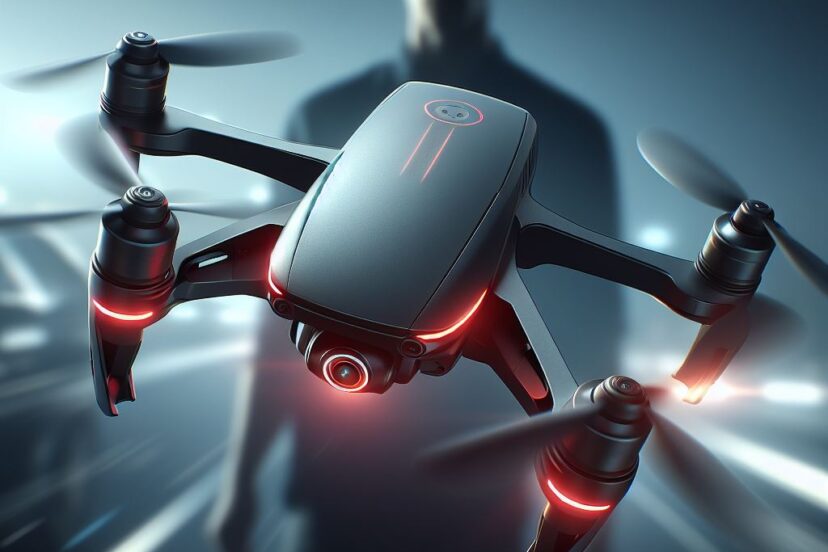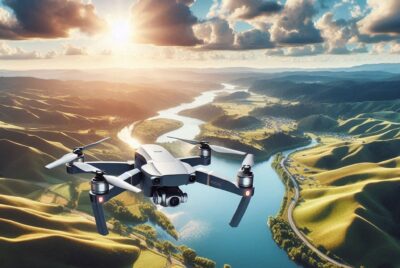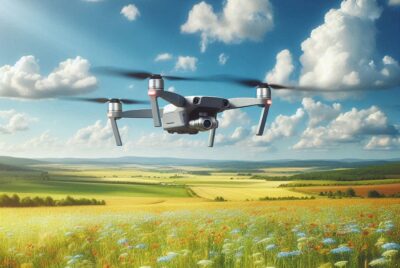Autonomous Drone: Enhancing Security and Surveillance
*We may earn a commission for purchases made using our links. Please see our disclosure to learn more.
Autonomous Drone Advancements: The Future of Unmanned Flight Technology
The autonomous drone, often referred to as unmanned aerial vehicles (UAVs), represents a significant leap in technology, offering a blend of advanced robotics, artificial intelligence, and aviation. These machines are capable of navigating without human input, relying on a variety of sensors, cameras, and algorithms to pilot themselves through a range of environments. My knowledge of these drones indicates they’re being increasingly leveraged for a wide array of applications due to their efficiency and the convenience they offer.

My experience with autonomous drones has shown me their profound impact across multiple sectors. Industrial sites, for example, harness the power of these drones to carry out inspections, mapping, and surveillance tasks that would otherwise be dangerous or challenging for human workers. With the integration of AI, drones can now gather and analyze data, offering valuable insights that drive decision-making in industries from agriculture to logistics.
As someone who keeps up with emerging technologies, I’ve observed that key features of autonomous drones, such as obstacle avoidance, predetermined flight modes, and the ability to adapt to changing conditions, make them incredibly versatile tools. The Potensic and DJI models demonstrate advancements in camera technology and flight capabilities, while Skydio’s drones fuse AI supercomputers with multiple cameras for various video capture styles, operating without the need for human interaction. These capabilities underscore a future where drones will become commonplace, serving sophisticated roles that extend beyond recreational use.
Fundamentals of Autonomous Drones
In exploring the fundamentals of autonomous drones, I’ll discuss the technological underpinnings that enable these devices to operate independently, the essential components that constitute a drone, the sophisticated operations that control their flight, and the integral safety regulations that govern their use.
Understanding Autonomous Technology
Autonomous drone technology leverages artificial intelligence (AI) to enable drones to make decisions without direct human control. By processing inputs from an array of sensors and navigating via pre-programmed instructions, these drones can perform complex tasks, impacting sectors like agriculture, delivery services, and public safety.
Key Components and Specifications
Autonomous drones are composed of several key components:
- Motors: Typically four in quadcopters, providing thrust and control.
- Sensors: Crucial for environmental detection and navigation; include GPS, gyroscopes, and collision detection.
- Battery: Determines the flight time; advancements are continuously made for longer duration.
- Camera: Varies in quality, essential for tasks such as inspection or surveillance.
Specifications such as weight and size directly affect a drone’s performance, influencing its payload capacity and maneuverability.
Autonomous Drone Operation and Control
Operation of an autonomous drone involves several critical processes:
- Tracking: Real-time location monitoring, often via GPS.
- Planning: AI algorithms plan flight paths to navigate and accomplish set objectives efficiently.
- Control: Onboard systems adjust the drone’s flight parameters in response to sensor data.
A pilot might oversee the drone for safety purposes, even though the drone is capable of independent operation.
Safety and Regulation Compliance
Safety features in autonomous drones are paramount for public safety. These include geofencing, auto-landing for low battery conditions, and obstacle avoidance systems. Compliance with regulations is critical; operators must adhere to local and international laws to ensure safe integration into national airspace and prevent conflicts with manned aircraft.
By understanding these foundations, we become better equipped to appreciate the innovative potential that autonomous drones hold and the responsibility that comes with deploying them.
Autonomous Drone Systems

In my examination of autonomous drone systems, I’ll explore their critical technologies for navigation, obstacle avoidance, and data processing. I’ll look specifically at how these drones intelligently understand and interact with their environment.
Navigation and GPS Integration
I understand that autonomous drones fundamentally rely on GPS to navigate. They use a series of waypoints to chart their course, which provides them with a predefined route to follow. The integration of GPS is pivotal, equipping drones with the capability to perform complex tasks like mapping with precision. These drones typically include an onboard computer that processes GPS data, correlating it with their flight patterns.
- GPS Functions:
- Waypoint Navigation: Drones use GPS coordinates to progress through a series of points.
- Mapping: Accurate geo-tagging helps in creating detailed maps and models.
Obstacle Detection and Avoidance
My research into autonomous drones reveals that obstacle avoidance is indispensable for safety and operational longevity. They are equipped with a variety of sensors and obstacle sensing techniques, such as ultrasonic, visual, or infrared, to navigate around obstacles. AI-powered software and computer vision play a major role, enabling the Obstacle Avoidance System to detect and maneuver around objects in real-time.
- Key Technologies:
- Computer Vision: Drones analyze visual input to identify obstacles.
- Sensors: Ultrasonic, LIDAR, and infrared sensors feed data to the avoidance systems.
Data Acquisition and Processing
My analysis highlights that autonomous drones are not only about flight but also about collecting and interpreting data. They are adept at gathering high-quality visual data and even thermal imaging, which contributes significantly to situational awareness. The AI-powered software processes the collected data onboard, which is vital for various applications like surveillance, agricultural monitoring, and industrial inspections.
- Data Functions:
- Visual Data: Captures detailed images and videos for analysis.
- Thermal Imaging: Monitors temperature variations for applications like infrastructure inspection.
By dissecting these systems, I’ve gained an appreciation for the sophisticated nature of autonomous drones and their potential to transform various industry sectors.
Drone Applications

In this section, I’ll cover the diverse range of applications drones have in commercial and industrial settings, public services, and the fields of photography and videography.
Commercial and Industrial Uses
Commercial and industrial sectors leverage drone technology for various applications to boost efficiency and productivity. One key industrial use is Surveying and Landmass Mapping, where I can conduct programmed tasks autonomously, leading to faster data collection compared to traditional methods. In agriculture, drones equipped with advanced sensors help monitor crop health, enhancing farm productivity. Additionally, the Drone-in-a-Box systems offer an all-in-one solution for industrial sites, streamlining operations like routine Inspection with minimal human intervention.
- Applications:
- Surveying
- Agriculture productivity enhancement
- Industrial inspection
- Performance Enhancers:
- Autonomous navigation
- Real-time data processing
Public Service and Security
I am increasingly integral in public service and security operations. Drones are deployed for Surveillance and augmenting public safety by providing an aerial overview during critical situations. In Search and Rescue Operations, I enhance the speed and success rates, helping locate individuals in challenging terrains. My capabilities are vital for Rescue missions, often contributing to saving lives and aiding first responders.
- Security Functions:
- Aerial surveillance
- Incident monitoring
- Public Service Contributions:
- Search and rescue missions
- Public safety support
Photography and Videography
Drones have revolutionized Aerial Photography and Videography, especially with the integration of a 3-Axis Gimbal and 4K Camera. As a drone, I can capture high-resolution images and stable video footage, which is invaluable in film production and real estate. The ability to shoot from varied angles without human intervention offers creative freedoms previously unattainable.
- Visual Proficiencies:
- High-resolution imagery
- Stable aerial footage
- Popular Uses:
- Film and commercial production
- Real estate showcases
Advanced Autonomous Drone Features

In this era of technological advancement, drones have become powerhouses of autonomous capabilities, integrating complex features that allow for sophisticated flight operations and imaging. Let’s explore the depth of these functionalities that sit at the forefront of drone innovation.
Intelligent Flight and Imaging Modes
I will focus on how drones now include Intelligent Flight Modes like ActiveTrack and Quickshots which enable them to autonomously track subjects and perform predefined aerial maneuvers. My flight experiences are enriched by modes like Follow Me, which commands the drone to follow the subject seamlessly, and Return to Home, ensuring safe recall of the drone to its takeoff point.
Enhanced Performance Technologies
Drones have embraced Enhanced Performance Technologies that redefine what it means to be agile in the air. Utilizing advanced flight automation, drones can achieve impressive speeds and agility, markedly improving flight performance. This kind of automation also enables advanced functionalities such as thermal cameras and zoom capabilities, allowing for detailed imaging from a distance.
AI and Machine Learning Integration
The fusion of Artificial Intelligence (AI) and Machine Learning in drones has revolutionized their capabilities. AI-Powered Software and Computer Vision equip drones to intelligently navigate their environment, adapt to changes, and learn from each flight, enhancing their precision and decision-making prowess with each operation.
Communication Systems in an Autonomous Drone
Communication forms the backbone of drone operation. Integration with 5G technology ensures high-speed data transfer, low latency, and increased reliability. This enables me to operate my drone in real-time with unparalleled responsiveness, all while transmitting high-definition media content.
Multi-Drone Operation and Management
Finally, managing Multi-Drone Operations positions me to effectively coordinate Swarms or fleets, paving the way for synchronous flight patterns and complex tasks. I utilize Fleet Management systems to monitor the health and performance of each drone, optimizing operations on a wide scale.
Considerations for Autonomous Drone Buyers and Pilots

When considering the purchase and operation of a drone, it’s important for me to factor in the purpose of the drone, its performance capabilities, and the maintenance it will require.
Selecting the Right Drone Model
In selecting the right drone model, I carefully consider what I aim to achieve with it. The specs of a drone—like roll, pitch, speed, range, and flight time—are tailored for different uses. For aerial photography, drones like the DJI Air 2S with high-resolution cameras and stable flight controls are ideal. If I’m looking for an entry-level drone, the DJI Mini 2 or the Holy Stone HS700E are both cost-effective with decent performance. For professional filmmaking, a more advanced model like the DJI Inspire 2 meets the high standards required.
Understanding Autonomous Drone Performance Metrics
Performance metrics such as speed, range, and flight time play a pivotal role in my purchase decision. Here’s how some popular drones measure up:
| Drone Model | Speed (Max) | Range (Max) | Flight Time (Max) |
| DJI Mini 2 | 35.8 mph | 6.2 miles | 31 minutes |
| Potensic Dreamer Pro | 31 mph | 1.24 miles | 28 minutes |
| Parrot Anafi | 33 mph | 2.5 miles | 25 minutes |
| Holy Stone HS700E | —- | —- | 23 minutes |
| DJI Mavic Air | 42.5 mph | 6.2 miles | 21 minutes |
| Skydio | 36 mph | —- | 23 minutes |
| DJI Air 2S | 42.5 mph | 7.5 miles | 31 minutes |
Consider the payload capacity as well, especially if I plan to use the drone for commercial deliveries or industrial inspections.
Maintenance and Upkeep
Maintenance and upkeep are crucial for the longevity and safe operation of a drone. I adhere to the manufacturer’s maintenance schedule, ensure routine checks for firmware updates, and inspect key components such as propellers and batteries before each flight. Owning a drone like a DJI Mavic Air or Skydio implies regular cleaning and calibration to maintain their sophisticated sensors and cameras. It’s important for me to budget for occasional repairs and replacements to maintain performance over time.
Evolution and Future of the Autonomous Drone
I will explore the remarkable journey of drone technology, focusing on the trends and innovations that have shaped this field. I will also discuss the wide-ranging applications and the crucial role of regulatory frameworks that govern the use of autonomous drones.
Trends in Autonomous Drone Technology
Autonomous drone technology has evolved significantly, with artificial intelligence (AI) and machine learning algorithms at the forefront, enabling drones to perform complex tasks with minimal human intervention. These advancements have resulted in drones with enhanced navigational capabilities and decision-making autonomy. Recent trends see drones becoming increasingly smaller and more agile, a testament to the innovative design and engineering behind these machines.
Expanding Capabilities and Use Cases
The capabilities of autonomous drones are fast expanding beyond the conventional surveillance and military applications. Today, I see drones being deployed for a variety of new applications such as aerial photography, agricultural monitoring, disaster response, and package delivery. The development of air taxi services is perhaps one of the most anticipated applications proffered by the advanced capabilities of autonomous flight.
- Delivery Services: Drones are quickly becoming a feasible option for last-mile deliveries in urban and remote areas alike.
- Environmental Monitoring: Use of drones in monitoring wildlife, vegetation, and tracking environmental changes.
Regulatory and Ethical Considerations
As the proliferation of autonomous drones continues, legislation and policy play a pivotal role in ensuring safe skies. Ethical considerations, such as privacy and data protection, are equally important as these technologies become intertwined with everyday life. International laws and FAA regulations are continually shaping up to address the challenges posed by rapid growth and the introduction of new applications in the drone sector.
- Privacy Concerns: How drones capture and manage data affecting individuals’ privacy rights.
- Airspace Management: Ensuring the safe coexistence of manned and unmanned aircraft in shared airspace.
FAQs About Your Autonomous Drone
In this section, I explore some of the most pressing queries people have about autonomous drones, from navigation and legal concerns to technology and costs.
1. How do autonomous drones navigate without human intervention?
Autonomous drones rely on sophisticated sensors, GPS, and vision systems to navigate. My thorough understanding is that they utilize algorithms and artificial intelligence to process data from their sensors to orient themselves and travel to their destinations without human control.
2. What are the legal implications of operating autonomous drones?
The operation of autonomous drones falls under various regulations that address airspace usage, privacy, and safety. I’m aware the Federal Aviation Administration (FAA) provides guidelines, which operators must adhere to, including registering the drone and following specific flight rules.
3. What distinguishes military-grade autonomous drones from commercial ones?
Military drones typically have advanced capabilities such as greater endurance, payload capacity, and are equipped for specific missions including surveillance or combat. I recognize that commercial drones are designed more for civilian use, focusing on aspects like aerial photography, inspections, or agriculture.
4. What factors contribute to the cost of autonomous drones?
The cost of autonomous drones is influenced by factors like technology, design, and the materials used for construction. My analysis shows that sophisticated navigation systems, durability, and specialized features for specific tasks also play a significant role in the overall cost.
5. How has the field of autonomous drone delivery evolved in recent years?
The evolution of drone delivery in recent years has seen a significant increase in trials and the deployment of services in urban and rural areas. I have observed that advancements in battery life, payload capacity, and regulatory approvals have expanded the potential for drone-based delivery solutions.




